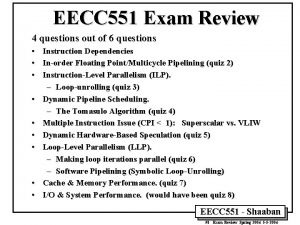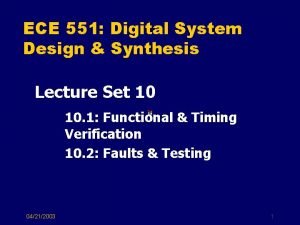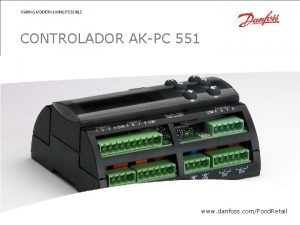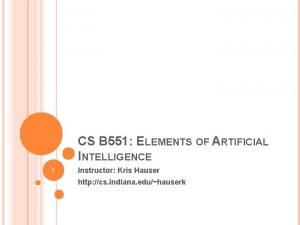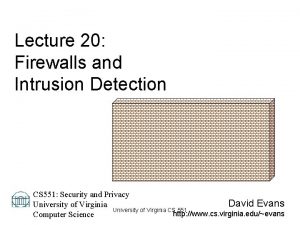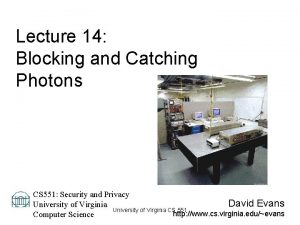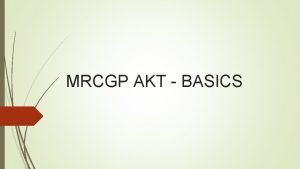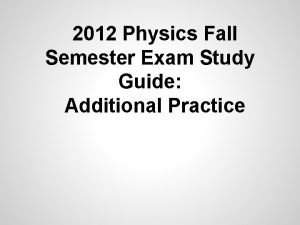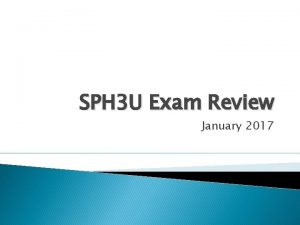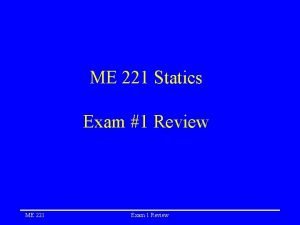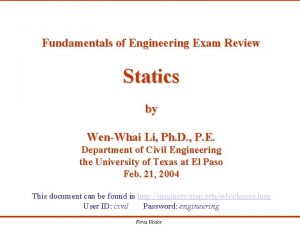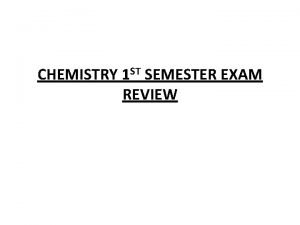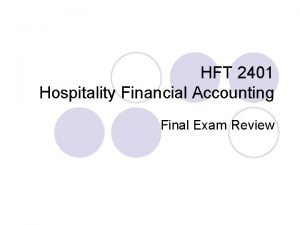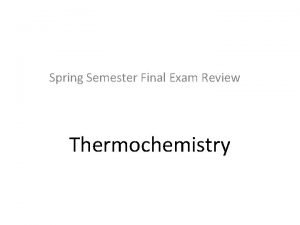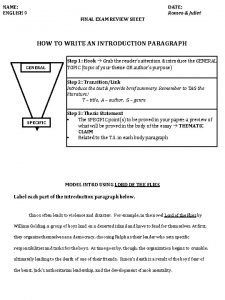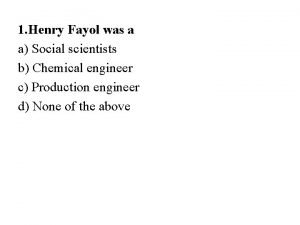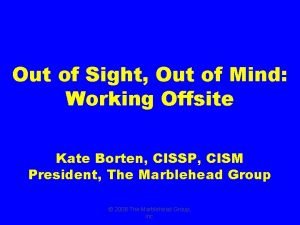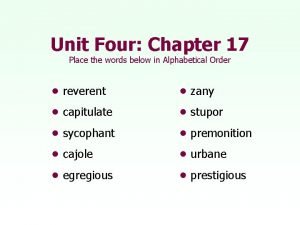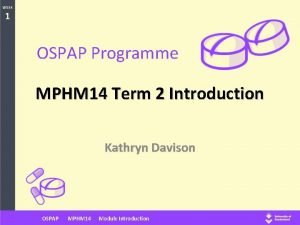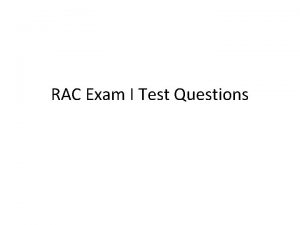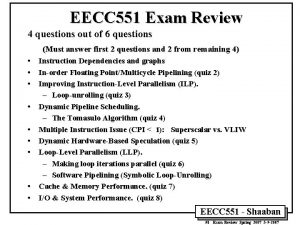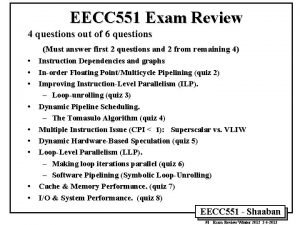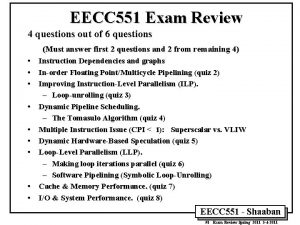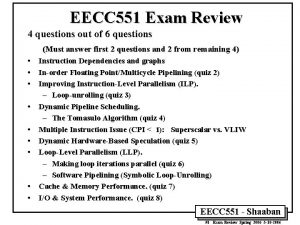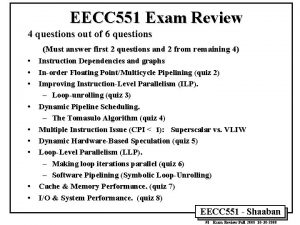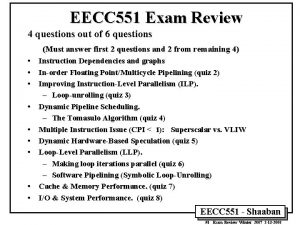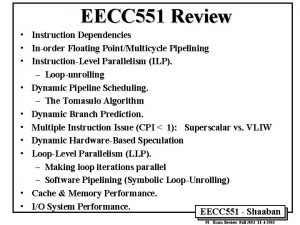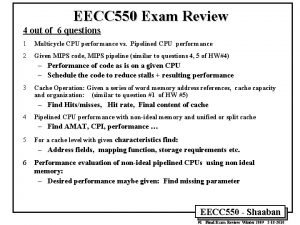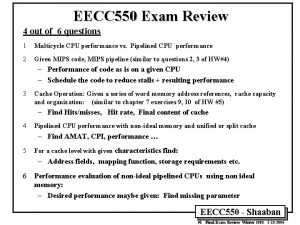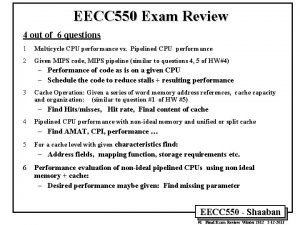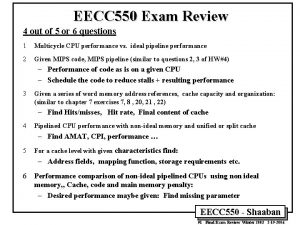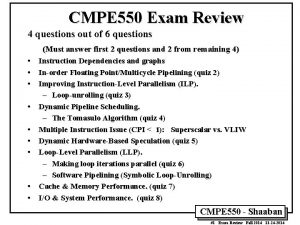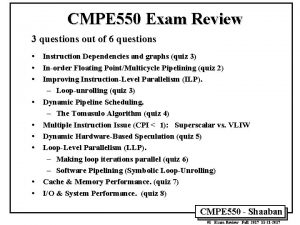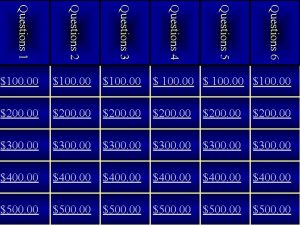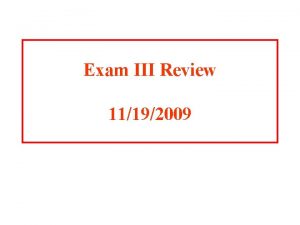EECC 551 Exam Review 4 questions out of








![MIPS Loop Unrolling Example • For the loop: for (i=1000; i>0; i=i-1) x[i] = MIPS Loop Unrolling Example • For the loop: for (i=1000; i>0; i=i-1) x[i] =](https://slidetodoc.com/presentation_image/21184150a98e7eafaf21907f835c3fbc/image-9.jpg)




























![LLP Analysis Example 1 • In the loop: for (i=1; i<=100; i=i+1) { A[i+1] LLP Analysis Example 1 • In the loop: for (i=1; i<=100; i=i+1) { A[i+1]](https://slidetodoc.com/presentation_image/21184150a98e7eafaf21907f835c3fbc/image-38.jpg)

![LLP Analysis Example 2 Original Loop: Iteration 1 for (i=1; i<=100; i=i+1) { A[i] LLP Analysis Example 2 Original Loop: Iteration 1 for (i=1; i<=100; i=i+1) { A[i]](https://slidetodoc.com/presentation_image/21184150a98e7eafaf21907f835c3fbc/image-40.jpg)
















































- Slides: 88

EECC 551 Exam Review 4 questions out of 6 questions • Instruction Dependencies • In-order Floating Point/Multicycle Pipelining (quiz 2) • Instruction-Level Parallelism (ILP). – Loop-unrolling (quiz 3) • Dynamic Pipeline Scheduling. – The Tomasulo Algorithm (quiz 4) • Multiple Instruction Issue (CPI < 1): Superscalar vs. VLIW • Dynamic Hardware-Based Speculation (quiz 5) • Loop-Level Parallelism (LLP). – Making loop iterations parallel (quiz 6) – Software Pipelining (Symbolic Loop-Unrolling) • Cache & Memory Performance. (quiz 7) • I/O & System Performance. (would have been quiz 8) EECC 551 - Shaaban #1 Exam Review Spring 2004 5 -5 -2004

Data Hazard/Dependence Classification I (Write) I (Read) Shared Operand True Data Dependence J (Read) J Read after Write (RAW) if data dependence is violated Program Order A name dependence: antidependence Shared Operand J (Write) Write after Read (WAR) if antidependence is violated I (Read) I (Write) A name dependence: output dependence I. . Shared Operand J (Write) Write after Write (WAW) if output dependence is violated No dependence Shared Operand J (Read) Read after Read (RAR) not a hazard EECC 551 - Shaaban #2 Exam Review Spring 2004 5 -5 -2004

Instruction Dependence Example 1 Dependency Graph L. D F 0, 0 (R 1) 2 ADD. D F 4, F 0, F 2 3 Example Code 1 2 3 4 5 6 L. D ADD. D S. D F 0, 0 (R 1) F 4, F 0, F 2 F 4, 0(R 1) F 0, -8(R 1) F 4, F 0, F 2 F 4, -8(R 1) S. D F 4, 0(R 1) Date Dependence: (1, 2) (2, 3) (4, 5) 4 (5, 6) Output Dependence: (1, 4) (2, 5) L. D F 0, -8 (R 1) 5 Anti-dependence: (2, 4) (3, 5) ADD. D F 4, F 0, F 2 6 S. D F 4, -8 (R 1) Can instruction 3 (first S. D) be moved just after instruction 4 (second L. D)? How about moving 3 after 5 (the second ADD. D)? If not what dependencies are violated? Can instruction 4 (second L. D) be moved just after instruction 1 (first L. D)? If not what dependencies are violated? EECC 551 - Shaaban #3 Exam Review Spring 2004 5 -5 -2004

Control Dependencies • • • Determines the ordering of an instruction with respect to a branch instruction. Every instruction in a program except those in the very first basic block of the program is control dependent on some set of branches. An instruction which is control dependent on a branch cannot be moved before the branch so that its execution is no longer controlled by the branch. An instruction which is not control dependent on the branch cannot be moved so that its execution is controlled by the branch (in then portion) It’s possible in some cases to violate these constraints and still have correct execution. Example of control dependence in then part of an if statement: if p 1 { S 1; }; If p 2 { S 2; } (In Chapter 3. 1) S 1 is control dependent on p 1 S 2 is control dependent on p 2 but not on p 1 What happens if S 1 is moved here? EECC 551 - Shaaban #4 Exam Review Spring 2004 5 -5 -2004

Floating Point/Multicycle Pipelining in MIPS • Completion of MIPS EX stage floating point arithmetic operations in one or two cycles is impractical since it requires: • A much longer CPU clock cycle, and/or • An enormous amount of logic. • Instead, the floating-point pipeline will allow for a longer latency. • Floating-point operations have the same pipeline stages as the integer instructions with the following differences: – The EX cycle may be repeated as many times as needed. – There may be multiple floating-point functional units. – A stall will occur if the instruction to be issued either causes a structural hazard for the functional unit or cause a data hazard. • The latency of functional units is defined as the number of intervening cycles between an instruction producing the result and the instruction that uses the result (usually equals stall cycles with forwarding used). • The initiation or repeat interval is the number of cycles that must elapse between issuing an instruction of a given type. (In Appendix A) EECC 551 - Shaaban #5 Exam Review Spring 2004 5 -5 -2004

Extending The MIPS In-order Integer Pipeline: Multiple Outstanding Floating Point Operations Latency = 6 Initiation Interval = 1 Pipelined Integer Unit Latency = 0 Initiation Interval = 1 Hazards: RAW, WAW possible WAR Not Possible Structural: Possible Control: Possible Floating Point (FP)/Integer Multiply IF ID Latency = 3 Initiation Interval = 1 Pipelined (In Appendix A) EX FP Adder MEM WB FP/Integer Divider Latency = 24 Initiation Interval = 25 Non-pipelined EECC 551 - Shaaban #6 Exam Review Spring 2004 5 -5 -2004

FP Code RAW Hazard Stalls Example (with full data forwarding in place) CC 1 CC 2 IF ID MUL. D F 0, F 4, F 6 IF CC 3 CC 4 CC 5 CC 6 EX MEM WB ID STALL M 1 M 2 IF STALL ID IF CC 7 CC 8 CC 9 CC 10 CC 11 CC 12 CC 13 M 7 MEM WB STALL STALL A 1 A 2 STALL STALL ID EX CC 14 CC 15 CC 16 CC 17 A 3 A 4 MEM WB CC 18 L. D F 4, 0(R 2) ADD. D F 2, F 0, F 8 S. D F 2, 0(R 2) M 3 M 4 M 5 M 6 6 stall cycles which equals latency of FP add functional unit (In Appendix A) (quiz 2) STALL MEM WB Third stall due to structural hazard in MEM stage EECC 551 - Shaaban #7 Exam Review Spring 2004 5 -5 -2004

Increasing Instruction-Level Parallelism • A common way to increase parallelism among instructions is to exploit parallelism among iterations of a loop – (i. e Loop Level Parallelism, LLP). • This is accomplished by unrolling the loop either statically by the compiler, or dynamically by hardware, which increases the size of the basic block present. This resulting larger basic block provides more instructions that can scheduled or re-ordered to eliminate more stall cycles. • In this loop every iteration can overlap with any other iteration. Overlap within each iteration is minimal. for (i=1; i<=1000; i=i+1; ) x[i] = x[i] + y[i]; • In vector machines, utilizing vector instructions is an important alternative to exploit loop-level parallelism, • Vector instructions operate on a number of data items. The above loop would require just four such instructions. EECC 551 - Shaaban (In Chapter 4. 1) #8 Exam Review Spring 2004 5 -5 -2004
![MIPS Loop Unrolling Example For the loop for i1000 i0 ii1 xi MIPS Loop Unrolling Example • For the loop: for (i=1000; i>0; i=i-1) x[i] =](https://slidetodoc.com/presentation_image/21184150a98e7eafaf21907f835c3fbc/image-9.jpg)
MIPS Loop Unrolling Example • For the loop: for (i=1000; i>0; i=i-1) x[i] = x[i] + s; The straightforward MIPS assembly code is given by: Loop: L. D ADD. D S. D DADDUI BNE F 0, 0 (R 1) F 4, F 0, F 2 F 4, 0(R 1) R 1, # -8 R 1, R 2, Loop ; F 0=array element ; add scalar in F 2 ; store result ; decrement pointer 8 bytes ; branch R 1!=R 2 R 1 is initially the address of the element with highest address. 8(R 2) is the address of the last element to operate on. (In Chapter 4. 1) (quiz 3) (Basic block size = 5 instructions) EECC 551 - Shaaban #9 Exam Review Spring 2004 5 -5 -2004

MIPS FP Latency For Loop Unrolling Example • All FP units assumed to be pipelined. • The following FP operations latencies are used: (or Number of Stall Cycles) Instruction Producing Result Instruction Using Result Latency In Clock Cycles FP ALU Op Another FP ALU Op 3 FP ALU Op Store Double 2 Load Double FP ALU Op 1 Load Double Store Double 0 Branch resolved in decode stage, Branch penalty = 1 cycle, Full forwarding is used (In Chapter 4. 1) EECC 551 - Shaaban #10 Exam Review Spring 2004 5 -5 -2004

Loop Unrolling Example (continued) • This loop code is executed on the MIPS pipeline as follows: (Branch resolved in decode stage, Branch penalty = 1 cycle, Full forwarding is used) No scheduling Clock cycle Loop: L. D F 0, 0(R 1) 1 stall 2 ADD. D F 4, F 0, F 2 3 stall 4 stall 5 S. D F 4, 0 (R 1) 6 DADDUI R 1, # -8 7 stall 8 BNE R 1, R 2, Loop 9 stall 10 10 cycles per iteration (In Chapter 4. 1) Scheduled with single delayed branch slot Loop: L. D DADDUI ADD. D stall BNE S. D F 0, 0(R 1) R 1, # -8 F 4, F 0, F 2 R 1, R 2, Loop F 4, 8(R 1) 6 cycles per iteration 10/6 = 1. 7 times faster EECC 551 - Shaaban #11 Exam Review Spring 2004 5 -5 -2004

Loop Unrolling Example (continued) Cycle No scheduling Loop: 1 L. D 2 Stall 3 4 5 6 ADD. D F 4, F 0, F 2 7 8 9 10 11 12 13 14 15 16 17 18 • F 0, 0(R 1) • Stall SD LD Stall F 4, 0 (R 1) F 6, -8(R 1) The resulting loop code when four copies of the loop body are unrolled without reuse of registers. The size of the basic block increased from 5 instructions in the original loop to 14 instructions. ; drop DADDUI & BNE Three branches and three decrements of R 1 are eliminated. ADDD F 8, F 6, F 2 Stall SD LD Stall F 8, -8 (R 1), F 10, -16(R 1) ; drop DADDUI & BNE ADDD F 12, F 10, F 2 Stall SD LD 19 20 Stall 21 ADDD 22 Stall 23 Stall 24 SD F 12, -16 (R 1) ; drop DADDUI F 14, -24 (R 1) F 16, F 14, F 2 F 16, -24(R 1) 25 DADDUI R 1, # -32 26 Stall 27 BNE 28 Stall (In Chapter 4. 1) & BNE Load and store addresses are changed to allow DADDUI instructions to be merged. The unrolled loop runs in 28 cycles assuming each L. D has 1 stall cycle, each ADD. D has 2 stall cycles, the DADDUI 1 stall, the branch 1 stall cycle, or 28/4 = 7 cycles to produce each of the four elements. R 1, R 2, Loop EECC 551 - Shaaban #12 Exam Review Spring 2004 5 -5 -2004

Loop Unrolling Example (continued) When scheduled for pipeline Loop: L. D ADD. D S. D DADDUI S. D BNE S. D (In Chapter 4. 1) The execution time of the loop has dropped to 14 cycles, or 14/4 = 3. 5 clock cycles per element F 0, 0(R 1) F 6, -8 (R 1) compared to 6. 8 before scheduling F 10, -16(R 1) and 6 when scheduled but unrolled. F 14, -24(R 1) F 4, F 0, F 2 Unrolling the loop exposed more F 8, F 6, F 2 computations that can be scheduled F 12, F 10, F 2 to minimize stalls by increasing the F 16, F 14, F 2 size of the basic block from 5 instructions F 4, 0(R 1) in the original loop to 14 instructions F 8, -8(R 1) in the unrolled loop. R 1, # -32 F 12, 16(R 1), F 12 R 1, R 2, Loop F 16, 8(R 1), F 16 ; 8 -32 = -24 EECC 551 - Shaaban #13 Exam Review Spring 2004 5 -5 -2004

Dynamic Pipeline Scheduling • Dynamic instruction scheduling is accomplished by: – Dividing the Instruction Decode ID stage into two stages: • Issue: Decode instructions, check for structural hazards. • Read operands: Wait until data hazard conditions, if any, are resolved, then read operands when available. (All instructions pass through the issue stage in order but can be stalled or pass each other in the read operands stage). – In the instruction fetch stage IF, fetch an additional instruction every cycle into a latch or several instructions into an instruction queue. – Increase the number of functional units to meet the demands of the additional instructions in their EX stage. • Two dynamic scheduling approaches exist: – Dynamic scheduling with a Scoreboard used first in CDC 6600 – The Tomasulo approach pioneered by the IBM 360/91 (1966) (In Appendix A. 8, Chapter 3. 2) (1963) EECC 551 - Shaaban #14 Exam Review Spring 2004 5 -5 -2004

Tomasulo Algorithm Vs. Scoreboard • • • Control & buffers distributed with Function Units (FU) Vs. centralized in Scoreboard: – FU buffers are called “reservation stations” which have pending instructions and operands and other instruction status info. – Reservations stations are sometimes referred to as “physical registers” or “renaming registers” as opposed to architecture registers specified by the ISA Registers in instructions are replaced by either values (if available) or pointers to reservation stations (RS) that will supply the value later: – This process is called register renaming. – Avoids WAR, WAW hazards. – Allows for hardware-based loop unrolling. – More reservation stations than ISA registers are possible , leading to optimizations that compilers can’t achieve and prevents the number of ISA registers from becoming a bottleneck. Instruction results go (forwarded) to FUs from RSs, not through registers, over Common Data Bus (CDB) that broadcasts results to all FUs. Loads and Stores are treated as FUs with RSs as well. Integer instructions can go past branches, allowing FP ops beyond basic block in FP queue. (In Chapter 3. 2) EECC 551 - Shaaban #15 Exam Review Spring 2004 5 -5 -2004

Dynamic Scheduling: The Tomasulo Approach The basic structure of a MIPS floating-point unit using Tomasulo’s algorithm (In Chapter 3. 2) EECC 551 - Shaaban #16 Exam Review Spring 2004 5 -5 -2004

Reservation Station Fields • Op Operation to perform in the unit (e. g. , + or –) • Vj, Vk Value of Source operands S 1 and S 2 – Store buffers have a single V field indicating result to be stored. • Qj, Qk Reservation stations producing source registers. (value to be written). – No ready flags as in Scoreboard; Qj, Qk=0 => ready. – Store buffers only have Qi for RS producing result. • A: Address information for loads or stores. Initially immediate field of instruction then effective address when calculated. • Busy: Indicates reservation station and FU are busy. • Register result status: Qi Indicates which functional unit will write each register, if one exists. – Blank (or 0) when no pending instructions exist that EECC 551 - Shaaban will write to that register. (In Chapter 3. 2) #17 Exam Review Spring 2004 5 -5 -2004

1 Three Stages of Tomasulo Algorithm Issue: Get instruction from pending Instruction Queue. – Instruction issued to a free reservation station (no structural hazard). – Selected RS is marked busy. – Control sends available instruction operands values (from ISA registers) to assigned RS. – Operands not available yet are renamed to RSs that will produce the operand (register renaming). 2 Execution (EX): Operate on operands. – When both operands are ready then start executing on assigned FU. – If all operands are not ready, watch Common Data Bus (CDB) for needed result (forwarding done via CDB). 3 Write result (WB): Finish execution. – – Write result on Common Data Bus to all awaiting units Mark reservation station as available. • Normal data bus: data + destination (“go to” bus). • Common Data Bus (CDB): data + source (“come from” bus): – 64 bits for data + 4 bits for Functional Unit source address. – Write data to waiting RS if source matches expected RS (that produces result). – Does the result forwarding via broadcast to waiting RSs. (In Chapter 3. 2) EECC 551 - Shaaban #18 Exam Review Spring 2004 5 -5 -2004

Tomasulo Approach Example Using the same code used in the scoreboard example to be run on the Tomasulo configuration given earlier: # of RSs Integer Floating Point Multiply/divide Floating Point add L. D F 6, 34(R 2) L. D F 2, 45(R 3) MUL. D F 0, F 2, F 4 SUB. D F 8, F 6, F 2 DIV. D F 10, F 6 ADD. D F 6, F 8, F 2 (In Chapter 3. 3) 1 2 3 EX Latency 0 10/40 2 Pipelined Functional Units Real Data Dependence (RAW) Anti-dependence (WAR) Output Dependence (WAW) EECC 551 - Shaaban #19 Exam Review Spring 2004 5 -5 -2004

Tomasulo Example: Cycle 57 Execution complete 3 4 15 7 56 10 S 1 Vj Write Result 4 5 16 8 57 11 S 2 Vk RS for j Qj RS for k Qk F 0 F 2 F 4 F 6 F 8 M*F 4 M(45+R 3) (M–M)+M() M()–M() M*F 4/M Instruction status j k Issue Instruction L. D F 6 34+ R 2 1 L. D F 2 45+ R 3 2 MUL. D F 0 F 2 F 4 3 SUB. D F 8 F 6 F 2 4 DIV. D F 10 F 6 5 ADD. D F 6 F 8 F 2 6 Reservation Stations Time Name Busy Op 0 Add 1 No 0 Add 2 No Add 3 No 0 Mult 1 No 0 Mult 2 No Register result status Clock 57 FU Load 1 Load 2 Load 3 Busy No No No Address Instruction Block done F 10 F 12. . . F 30 • We have: • In-oder issue, • Out-of-order execution, completion (quiz 4) EECC 551 - Shaaban #20 Exam Review Spring 2004 5 -5 -2004

Tomasulo Loop Example Loop: L. D MUL. D S. D DADDUI BNE F 0, 0(R 1) F 4, F 0, F 2 F 4, 0(R 1) R 1, # -8 R 1, R 2, Loop ; branch if R 1 = R 2 • Assume Multiply takes 4 clocks. • Assume first load takes 8 clocks (possibly due to a cache miss), second load takes 4 clocks (cache hit). • Assume R 1 = 80 initially. • Assume branch is predicted taken and no branch misprediction. • No branch delay slot is used in this example. • Stores take 4 cycles (ex, mem) and do not write on CDB • We’ll go over the execution to complete first two loop iterations. (Expanded from loop example in Chapter 3. 3) EECC 551 - Shaaban #21 Exam Review Spring 2004 5 -5 -2004

First two Loop iterations done Loop Example Cycle 19 Instruction status Instruction j k iteration L. D F 0 0 R 1 1 MUL. D F 4 F 0 F 2 1 S. D F 4 0 R 1 1 L. D F 0 0 R 1 2 MUL. D F 4 F 0 F 2 2 S. D F 4 0 R 1 2 Reservation Stations Time Name Busy Op 0 Add 1 No 0 Add 2 No 0 Add 3 No 1 Mult 1 Yes MULTD 0 Mult 2 No Register result status Clock 19 R 1 56 F 0 Qi Issue 1 2 3 6 7 8 S 1 Vj Execution Write complete Result 9 10 14 15 18 10 11 15 16 19 S 2 RS for j Vk Qj M(64) R(F 2) F 2 F 4 F 6 Busy Address Load 1 No Load 2 No Load 3 No Qi Store 1 No Store 2 0 Yes 72 M(72)*R(72) Store 3 Yes 64 Mult 1 RS for k Qk Code: L. D F 0, 0(R 1) MUL. D F 4, F 0, F 2 S. D F 4, 0(R 1) DADDUI R 1, #-8 BNE R 1, R 2, loop F 8 F 10 F 12. . . F 30 Mult 1 Second S. D done (No write on CDB for stores) Second loop iteration done Issue third iteration BNE EECC 551 - Shaaban #22 Exam Review Spring 2004 5 -5 -2004

Multiple Instruction Issue: CPI < 1 • To improve a pipeline’s CPI to be better [less] than one, and to utilize Instruction Level Parallelism (ILP) better, a number of independent instructions have to be issued in the same pipeline cycle. • Multiple instruction issue processors are of two types: – Superscalar: A number of instructions (2 -8) is issued in the same cycle, scheduled statically by the compiler or dynamically (Tomasulo). • Power. PC, Sun Ultra. Sparc, Alpha, HP 8000. . . – VLIW (Very Long Instruction Word): A fixed number of instructions (3 -6) are formatted as one long instruction word or packet (statically scheduled by the compiler). – Example: Explicitly Parallel Instruction Computer (EPIC) • Originally a joint HP/Intel effort. • ISA: Intel Architecture-64 (IA-64) 64 -bit address: • First CPU: Itanium, Q 1 2001. • Limitations of the approaches: – Available ILP in the program (both). – Specific hardware implementation difficulties (superscalar). – VLIW optimal compiler design issues. (Ch 3. 6, 3. 7, 4. 3, 4. 5) EECC 551 - Shaaban #23 Exam Review Spring 2004 5 -5 -2004

Unrolled Loop Example for Scalar (single-issue) Pipeline 1 Loop: 2 3 4 5 6 7 8 9 10 11 12 13 14 L. D ADD. D S. D DADDUI S. D BNE S. D F 0, 0(R 1) F 6, -8(R 1) F 10, -16(R 1) F 14, -24(R 1) F 4, F 0, F 2 F 8, F 6, F 2 F 12, F 10, F 2 F 16, F 14, F 2 F 4, 0(R 1) F 8, -8(R 1) R 1, #-32 F 12, 16(R 1) R 1, R 2, LOOP F 16, 8(R 1) L. D to ADD. D: 1 Cycle ADD. D to S. D: 2 Cycles ; 8 -32 = -24 14 clock cycles, or 3. 5 per iteration EECC 551 - Shaaban #24 Exam Review Spring 2004 5 -5 -2004

Loop Unrolling in Superscalar Pipeline: (1 Integer, 1 FP/Cycle) Integer instruction FP instruction Clock cycle Loop: L. D F 0, 0(R 1) 1 L. D F 6, -8(R 1) 2 L. D F 10, -16(R 1) ADD. D F 4, F 0, F 2 3 L. D F 14, -24(R 1) ADD. D F 8, F 6, F 2 4 L. D F 18, -32(R 1) ADD. D F 12, F 10, F 2 5 S. D F 4, 0(R 1) ADD. D F 16, F 14, F 2 6 S. D F 8, -8(R 1) ADD. D F 20, F 18, F 2 7 S. D F 12, -16(R 1) 8 DADDUI R 1, #-40 9 S. D F 16, -24(R 1) 10 BNE R 1, R 2, LOOP 11 SD -32(R 1), F 20 12 • Unrolled 5 times to avoid delays and expose more ILP (unrolled one more time) • 12 cycles, or 12/5 = 2. 4 cycles per iteration (3. 5/2. 4= 1. 5 X faster than scalar) • CPI = 12/ 17 =. 7 worse than ideal CPI =. 5 because 7 issue slots are wasted EECC 551 - Shaaban #25 Exam Review Spring 2004 5 -5 -2004

Loop Unrolling in VLIW Pipeline (2 Memory, 2 FP, 1 Integer / Cycle) Memory FP FP reference 1 reference 2 L. D F 0, 0(R 1) L. D F 6, -8(R 1) L. D F 10, -16(R 1) L. D F 14, -24(R 1) L. D F 18, -32(R 1) L. D F 22, -40(R 1) L. D F 26, -48(R 1) Int. op/ Clock operation 1 op. 2 branch 1 2 ADD. D F 4, F 0, F 2 ADD. D F 12, F 10, F 2 ADD. D F 8, F 6, F 2 ADD. D F 16, F 14, F 2 3 4 5 ADD. D F 20, F 18, F 2 ADD. D F 24, F 22, F 2 S. D F 4, 0(R 1) S. D F 8, -8(R 1) ADD. D F 28, F 26, F 2 S. D F 12, -16(R 1) S. D F 16, -24(R 1) DADDUI R 1, #-56 S. D F 24, 16(R 1) 8 9 6 7 S. D F 20, 24(R 1) S. D F 28, 8(R 1) BNE R 1, R 2, LOOP Unrolled 7 times to avoid delays and expose more ILP 7 results in 9 cycles, or 1. 3 cycles per iteration (2. 4/1. 3 =1. 8 X faster than 2 -issue superscalar, 3. 5/1. 3 = 2. 7 X faster than scalar) Average: about 23/9 = 2. 55 IPC (instructions per clock cycle) Ideal IPC =5, CPI =. 39 Ideal CPI =. 2 thus about 50% efficiency, 22 issue slots are wasted Note: Needs more registers in VLIW (15 vs. 6 in Superscalar) EECC 551 - Shaaban (In chapter 4. 3 pages 317 -318) EECC 551 - Shaaban #26 Exam Review Spring 2004 5 -5 -2004

Multiple Instruction Issue with Dynamic Scheduling Example Assumptions: Restricted 2 -way superscalar: 1 integer, 1 FP Issue Per Cycle One integer unit (for ALU, effective address) One integer unit for branch condition 2 CDBs Execution cycles: Integer: 1 cycle Load: 2 cycles (1 ex + 1 mem) FP add: 3 cycles Any instruction following a branch cannot start execution until branch condition is evaluated Branches are single issued, no delayed branch, perfect branch prediction Example on page 221 EECC 551 - Shaaban #27 Exam Review Spring 2004 5 -5 -2004

Three Loop Iterations on Restricted 2 -way Superscalar Tomasulo Only one CDB is needed in this case. EECC 551 - Shaaban #28 Exam Review Spring 2004 5 -5 -2004

Multiple Instruction Issue with Dynamic Scheduling Example Assumptions: The same loop in previous example On restricted 2 -way superscalar: 1 integer, 1 FP Issue Per Cycle Two integer units one for ALU, one for effective address One integer unit for branch condition 2 CDBs Execution cycles: Integer: 1 cycle Load: 2 cycles (1 ex + 1 mem) FP add: 3 cycles Any instruction following a branch cannot start execution until branch condition is evaluated Branches are single issued, no delayed branch, perfect branch prediction Example on page 223 EECC 551 - Shaaban #29 Exam Review Spring 2004 5 -5 -2004

Same three loop Iterations on Restricted 2 -way Superscalar Tomasulo but with Two integer units (one for ALU, one for effective address) (page 224) EECC 551 - Shaaban #30 Exam Review Spring 2004 5 -5 -2004

Dynamic Hardware-Based Speculation • Combines: – Dynamic hardware-based branch prediction – Dynamic Scheduling: issue multiple instructions in order and execute out of order. (Tomasulo) • Continue to dynamically issue, and execute instructions passed a conditional branch in the dynamically predicted branch direction, before control dependencies are resolved. – This overcomes the ILP limitations of the basic block size. – Creates dynamically speculated instructions at run-time with no compiler support at all. – If a branch turns out as mispredicted all such dynamically speculated instructions must be prevented from changing the state of the machine (registers, memory). • Addition of commit (retire, completion, or re-ordering) stage and forcing instructions to commit in their order in the code (i. e to write results to registers or memory). • Precise exceptions are possible since instructions must commit in order. EECC 551 - Shaaban #31 Exam Review Spring 2004 5 -5 -2004

Hardware-Based Speculation Speculative Execution + Tomasulo’s Algorithm EECC 551 - Shaaban #32 Exam Review Spring 2004 5 -5 -2004

Four Steps of Speculative Tomasulo Algorithm 1. Issue — Get an instruction from FP Op Queue If a reservation station and a reorder buffer slot are free, issue instruction & send operands & reorder buffer number for destination (this stage is sometimes called “dispatch”) 2. Execution — Operate on operands (EX) When both operands are ready then execute; if not ready, watch CDB for result; when both operands are in reservation station, execute; checks RAW (sometimes called “issue”) 3. Write result — Finish execution (WB) Write on Common Data Bus (CDB) to all awaiting FUs & reorder buffer; mark reservation station available. 4. Commit — Update registers, memory with reorder buffer result – When an instruction is at head of reorder buffer & the result is present, update register with result (or store to memory) and remove instruction from reorder buffer. – A mispredicted branch at the head of the reorder buffer flushes the reorder buffer (sometimes called “graduation”) Þ Instructions issue in order, execute (EX), write result (WB) out of order, but must commit in order. EECC 551 - Shaaban #33 Exam Review Spring 2004 5 -5 -2004

Multiple Issue with Speculation Example Branches still single issue Example on page 235 (quiz 5) EECC 551 - Shaaban #34 Exam Review Spring 2004 5 -5 -2004

Answer: Without Speculation EECC 551 - Shaaban #35 Exam Review Spring 2004 5 -5 -2004

Answer: 2 -way Superscalar Tomasulo With Speculation Branches Still Single Issue EECC 551 - Shaaban #36 Exam Review Spring 2004 5 -5 -2004

Loop-Level Parallelism (LLP) Analysis • Loop-Level Parallelism (LLP) analysis focuses on whether data accesses in later iterations of a loop are data dependent on data values produced in earlier iterations and possibly making loop iterations independent. e. g. in for (i=1; i<=1000; i++) x[i] = x[i] + s; the computation in each iteration is independent of the previous iterations and the loop is thus parallel. The use of X[i] twice is within a single iteration. ÞThus loop iterations are parallel (or independent from each other). • • Loop-carried Dependence: A data dependence between different loop iterations (data produced in earlier iteration used in a later one). LLP analysis is important in software optimizations such as loop unrolling since it usually requires loop iterations to be independent. LLP analysis is normally done at the source code level or close to it since assembly language and target machine code generation introduces a loopcarried name dependence in the registers used for addressing and incrementing. Instruction level parallelism (ILP) analysis, on the other hand, is usually done when instructions are generated by the compiler. (In Chapter 4. 4) EECC 551 - Shaaban #37 Exam Review Spring 2004 5 -5 -2004
![LLP Analysis Example 1 In the loop for i1 i100 ii1 Ai1 LLP Analysis Example 1 • In the loop: for (i=1; i<=100; i=i+1) { A[i+1]](https://slidetodoc.com/presentation_image/21184150a98e7eafaf21907f835c3fbc/image-38.jpg)
LLP Analysis Example 1 • In the loop: for (i=1; i<=100; i=i+1) { A[i+1] = A[i] + C[i]; /* S 1 */ B[i+1] = B[i] + A[i+1]; } /* S 2 */ } (Where A, B, C are distinct non-overlapping arrays) – S 2 uses the value A[i+1], computed by S 1 in the same iteration. This data dependence is within the same iteration (not a loop-carried dependence). Þ does not prevent loop iteration parallelism. – S 1 uses a value computed by S 1 in an earlier iteration, since iteration i computes A[i+1] read in iteration i+1 (loop-carried dependence, prevents parallelism). The same applies for S 2 for B[i] and B[i+1] ÞThese two dependencies are loop-carried spanning more than one iteration preventing loop parallelism. EECC 551 - Shaaban #38 Exam Review Spring 2004 5 -5 -2004

• In the loop: LLP Analysis Example 2 for (i=1; i<=100; i=i+1) { A[i] = A[i] + B[i]; B[i+1] = C[i] + D[i]; /* S 1 */ /* S 2 */ } – S 1 uses the value B[i] computed by S 2 in the previous iteration (loopcarried dependence) – This dependence is not circular: • S 1 depends on S 2 but S 2 does not depend on S 1. – Can be made parallel by replacing the code with the following: A[1] = A[1] + B[1]; Loop Start-up code for (i=1; i<=99; i=i+1) { Parallel B[i+1] = C[i] + D[i]; loop iterations A[i+1] = A[i+1] + B[i+1]; } B[101] = C[100] + D[100]; Loop Completion code (quiz 6) EECC 551 - Shaaban #39 Exam Review Spring 2004 5 -5 -2004
![LLP Analysis Example 2 Original Loop Iteration 1 for i1 i100 ii1 Ai LLP Analysis Example 2 Original Loop: Iteration 1 for (i=1; i<=100; i=i+1) { A[i]](https://slidetodoc.com/presentation_image/21184150a98e7eafaf21907f835c3fbc/image-40.jpg)
LLP Analysis Example 2 Original Loop: Iteration 1 for (i=1; i<=100; i=i+1) { A[i] = A[i] + B[i]; B[i+1] = C[i] + D[i]; } Iteration 2 S 1 A[1] = A[1] + B[1]; A[2] = A[2] + B[2]; S 2 B[2] = C[1] + D[1]; B[3] = C[2] + D[2]; . . . Loop-carried Dependence Iteration 99 Iteration 100 A[99] = A[99] + B[99]; A[100] = A[100] + B[100]; B[100] = C[99] + D[99]; B[101] = C[100] + D[100]; A[1] = A[1] + B[1]; for (i=1; i<=99; i=i+1) { B[i+1] = C[i] + D[i]; A[i+1] = A[i+1] + B[i+1]; } B[101] = C[100] + D[100]; Modified Parallel Loop: Loop Start-up code /* S 1 */ /* S 2 */ Iteration 1 A[1] = A[1] + B[1]; A[2] = A[2] + B[2]; B[2] = C[1] + D[1]; B[3] = C[2] + D[2]; . . Not Loop Carried Dependence Iteration 98 Iteration 99 A[99] = A[99] + B[99]; A[100] = A[100] + B[100]; B[100] = C[99] + D[99]; B[101] = C[100] + D[100]; Loop Completion code EECC 551 - Shaaban #40 Exam Review Spring 2004 5 -5 -2004

ILP Compiler Support: Software Pipelining (Symbolic Loop Unrolling) – A compiler technique where loops are reorganized: • Each new iteration is made from instructions selected from a number of independent iterations of the original loop. – The instructions are selected to separate dependent instructions within the original loop iteration. – No actual loop-unrolling is performed. • A software equivalent to the Tomasulo approach? – Requires: • Additional start-up code to execute code left out from the first original loop iterations. • Additional finish code to execute instructions left out from the last original loop iterations. EECC 551 - Shaaban (In Chapter 4. 4) #41 Exam Review Spring 2004 5 -5 -2004

Show a software-pipelined version of the code: Loop: L. D ADD. D S. D DADDUI BNE F 0, 0(R 1) F 4, F 0, F 2 F 4, 0(R 1) R 1, #-8 R 1, R 2, LOOP start-up code Software Pipeline finish code Time Loop Unrolled Time Before: Unrolled 3 times 1 2 3 4 5 6 7 8 9 10 11 overlapped ops Software Pipelining Example L. D F 0, 0(R 1) ADD. D F 4, F 0, F 2 S. D F 4, 0(R 1) L. D F 0, -8(R 1) ADD. D F 4, F 0, F 2 S. D F 4, -8(R 1) L. D F 0, -16(R 1) ADD. D F 4, F 0, F 2 S. D F 4, -16(R 1) DADDUI R 1, #-24 BNE R 1, R 2, LOOP After: Software Pipelined L. D F 0, 0(R 1) start-up ADD. D F 4, F 0, F 2 code L. D F 0, -8(R 1) 1 S. D F 4, 0(R 1) ; Stores M[i] 2 ADD. D F 4, F 0, F 2 ; Adds to M[i-1] 3 L. D F 0, -16(R 1); Loads M[i-2] 4 DADDUI R 1, #-8 5 BNE R 1, R 2, LOOP S. D F 4, 0(R 1) finish code ADDD F 4, F 0, F 2 S. D F 4, -8(R 1) 2 fewer loop iterations EECC 551 - Shaaban #42 Exam Review Spring 2004 5 -5 -2004

Software Pipelining Example Illustrated Assuming 6 original iterations for illustration purposes: L. D ADD. D S. D F 0, 0(R 1) F 4, F 0, F 2 F 4, 0(R 1) 4 5 1 2 3 6 L. D L. D ADD. D S. D start-up code 1 2 3 4 finish code 4 Software Pipelined loop iterations (2 iterations fewer) EECC 551 - Shaaban #43 Exam Review Spring 2004 5 -5 -2004

Cache Concepts • Cache is the first level of the memory hierarchy once the address leaves the CPU and is searched first for the requested data. • If the data requested by the CPU is present in the cache, it is retrieved from cache and the data access is a cache hit otherwise a cache miss and data must be read from main memory. • On a cache miss a block of data must be brought in from main memory to cache to possibly replace an existing cache block. • The allowed block addresses where blocks can be mapped into cache from main memory is determined by cache placement strategy. • Locating a block of data in cache is handled by cache block identification mechanism. • On a cache miss the cache block being removed is handled by the block replacement strategy in place. • When a write to cache is requested, a number of main memory update strategies exist as part of the cache write policy. (Review from 550) EECC 551 - Shaaban #44 Exam Review Spring 2004 5 -5 -2004

Cache Performance: Average Memory Access Time (AMAT), Memory Stall cycles • The Average Memory Access Time (AMAT): The number of cycles required to complete an average memory access request by the CPU. • Memory stall cycles per memory access: The number of stall cycles added to CPU execution cycles for one memory access. • For ideal memory: AMAT = 1 cycle, this results in zero memory stall cycles. • Memory stall cycles per average memory access = (AMAT -1) • Memory stall cycles per average instruction = Memory stall cycles per average memory access x Number of memory accesses per instruction = (AMAT -1 ) x ( 1 + fraction of loads/stores) Instruction Fetch EECC 551 - Shaaban #45 Exam Review Spring 2004 5 -5 -2004

Cache Performance Princeton (Unified L 1) Memory Architecture CPUtime = Instruction count x CPI x Clock cycle time CPIexecution = CPI with ideal memory CPI = CPIexecution + Mem Stall cycles per instruction CPUtime = Instruction Count x (CPIexecution + Mem Stall cycles per instruction) x Clock cycle time Mem Stall cycles per instruction = Mem accesses per instruction x Miss rate x Miss penalty CPUtime = IC x (CPIexecution + Mem accesses per instruction x Miss rate x Miss penalty) x Clock cycle time Misses per instruction = Memory accesses per instruction x Miss rate CPUtime = IC x (CPIexecution + Misses per instruction x Miss penalty) x Clock cycle time (Review from 550) EECC 551 - Shaaban #46 Exam Review Spring 2004 5 -5 -2004

Memory Access Tree For Unified Level 1 Cache CPU Memory Access L 1 AMAT = L 1 Hit: % = Hit Rate = H 1 Access Time = 1 Stalls= H 1 x 0 = 0 ( No Stall) H 1 x 1 + L 1 Miss: % = (1 - Hit rate) = (1 -H 1) Access time = M + 1 Stall cycles per access = M x (1 -H 1) (1 -H 1 ) x (M+ 1) = 1 + M x ( 1 -H 1) Stall Cycles Per Access = AMAT - 1 = M x (1 -H 1) CPI = CPIexecution + Mem accesses per instruction x M x (1 -H 1) M = Miss Penalty H 1 = Level 1 Hit Rate 1 - H 1 = Level 1 Miss Rate EECC 551 - Shaaban #47 Exam Review Spring 2004 5 -5 -2004

Cache Performance Harvard Memory Architecture For a CPU with separate or split level one (L 1) caches for instructions and data (Harvard memory architecture) and no stalls for cache hits: CPUtime = Instruction count x CPI x Clock cycle time CPI = CPIexecution + Mem Stall cycles per instruction CPUtime = Instruction Count x (CPIexecution + Mem Stall cycles per instruction) x Clock cycle time Mem Stall cycles per instruction = Instruction Fetch Miss rate x Miss Penalty + Data Memory Accesses Per Instruction x Data Miss Rate x Miss Penalty EECC 551 - Shaaban #48 Exam Review Spring 2004 5 -5 -2004

Memory Access Tree For Separate Level 1 Caches CPU Memory Access Instruction Data L 1 Instruction L 1 Hit: Access Time = 1 Stalls = 0 Instruction L 1 Miss: Access Time = M + 1 Stalls Per access %instructions x (1 - Instruction H 1 ) x M Data L 1 Hit: Access Time: 1 Stalls = 0 Data L 1 Miss: Access Time : M + 1 Stalls per access: % data x (1 - Data H 1 ) x M Stall Cycles Per Access = % Instructions x ( 1 - Instruction H 1 ) x M + % data x (1 - Data H 1 ) x M AMAT = 1 + Stall Cycles per access EECC 551 - Shaaban #49 Exam Review Spring 2004 5 -5 -2004

1 Cache Write Strategies Write Though: Data is written to both the cache block and to a block of main memory. – The lower level always has the most updated data; an important feature for I/O and multiprocessing. – Easier to implement than write back. – A write buffer is often used to reduce CPU write stall while data is written to memory. 2 Write back: Data is written or updated only to the cache block. The modified or dirty cache block is written to main memory when it’s being replaced from cache. – Writes occur at the speed of cache – A status bit called a dirty or modified bit, is used to indicate whether the block was modified while in cache; if not the block is not written back to main memory. – Uses less memory bandwidth than write through. EECC 551 - Shaaban #50 Exam Review Spring 2004 5 -5 -2004

Cache Write Miss Policy • Since data is usually not needed immediately on a write miss two options exist on a cache write miss: Write Allocate: The cache block is loaded on a write miss followed by write hit actions. No-Write Allocate: The block is modified in the lower level (lower cache level, or main memory) and not loaded into cache. While any of the above two write miss policies can be used with either write back or write through: • Write back caches always use write allocate to capture subsequent writes to the block in cache. • Write through caches usually use no-write allocate since subsequent writes still have to go to memory. EECC 551 - Shaaban #51 Exam Review Spring 2004 5 -5 -2004

Memory Access Tree, Unified L 1 Write Through, No Write Allocate, No Write Buffer CPU Memory Access Read Write L 1 Read Hit: Access Time = 1 Stalls = 0 L 1 Read Miss: Access Time = M + 1 Stalls Per access % reads x (1 - H 1 ) x M Stall Cycles Per Memory Access = L 1 Write Hit: Access Time: M +1 Stalls Per access: % write x (H 1 ) x M L 1 Write Miss: Access Time : M + 1 Stalls per access: % write x (1 - H 1 ) x M % reads x (1 - H 1 ) x M + % write x M AMAT = 1 + % reads x (1 - H 1 ) x M + % write x M M = Miss Penalty H 1 = Level 1 Hit Rate 1 - H 1 = Level 1 Miss Rate EECC 551 - Shaaban #52 Exam Review Spring 2004 5 -5 -2004

Reducing Write Stalls For Write Though Cache • To reduce write stalls when write though is used, a write buffer is used to eliminate or reduce write stalls: – Perfect write buffer: All writes are handled by write buffer, no stalling for writes – In this case: Stall Cycles Per Memory Access = (No stalls for writes) % reads x (1 - H 1 ) x M – Realistic Write buffer: A percentage of write stalls are not eliminated when the write buffer is full. – In this case: Stall Cycles/Memory Access = ( % reads x (1 - H 1 ) + % write stalls not eliminated ) x M EECC 551 - Shaaban #53 Exam Review Spring 2004 5 -5 -2004

Write Through Cache Performance Example • • A CPU with CPIexecution = 1. 1 Mem accesses per instruction = 1. 3 Uses a unified L 1 Write Through, No Write Allocate, with: – No write buffer. – Perfect Write buffer – A realistic write buffer that eliminates 85% of write stalls Instruction mix: 50% arith/logic, 15% load, 15% store, 20% control Assume a cache miss rate of 1. 5% and a miss penalty of 50 cycles. CPI = CPIexecution + mem stalls per instruction % reads = 1. 15/1. 3 = 88. 5% % writes =. 15/1. 3 = 11. 5% With No Write Buffer : Mem Stalls/ instruction = 1. 3 x 50 x (88. 5% x 1. 5% + 11. 5%) = 8. 33 cycles CPI = 1. 1 + 8. 33 = 9. 43 With Perfect Write Buffer (all write stalls eliminated): Mem Stalls/ instruction = 1. 3 x 50 x (88. 5% x 1. 5%) = 0. 86 cycles CPI = 1. 1 + 0. 86 = 1. 96 With Realistic Write Buffer (eliminates 85% of write stalls) Mem Stalls/ instruction = 1. 3 x 50 x (88. 5% x 1. 5% + 15% x 11. 5%) = 1. 98 cycles CPI = 1. 1 + 1. 98 = 3. 08 EECC 551 - Shaaban #54 Exam Review Spring 2004 5 -5 -2004

Memory Access Tree Unified L 1 Write Back, With Write Allocate CPU Memory Access L 1 Hit: % write x H 1 Access Time = 1 Stalls = 0 L 1 Miss Clean Access Time = M +1 Stall cycles = M x (1 -H 1) x % clean Stall Cycles Per Memory Access = Dirty Access Time = 2 M +1 Stall cycles = 2 M x (1 -H 1) x % dirty 2 M needed to Write Dirty Block and Read new block (1 -H 1) x ( M x % clean + 2 M x % dirty ) AMAT = 1 + Stall Cycles Per Memory Access EECC 551 - Shaaban #55 Exam Review Spring 2004 5 -5 -2004

Write Back Cache Performance Example • A CPU with CPIexecution = 1. 1 uses a unified L 1 with write back, with write allocate, and the probability a cache block is dirty = 10% • Instruction mix: 50% arith/logic, 15% load, 15% store, 20% control • Assume a cache miss rate of 1. 5% and a miss penalty of 50 cycles. CPI = CPIexecution + mem stalls per instruction Mem Stalls per instruction = Mem accesses per instruction x Stalls per access Mem accesses per instruction = 1 +. 3 = 1. 3 Stalls per access = (1 -H 1) x ( M x % clean + 2 M x % dirty ) Stalls per access = 1. 5% x (50 x 90% + 100 x 10%) =. 825 cycles Mem Stalls per instruction = 1. 3 x. 825 = 1. 07 cycles AMAT = 1 + 1. 07 = 2. 07 cycles CPI = 1. 1 + 1. 07 = 2. 17 The ideal CPU with no misses is 2. 17/1. 1 = 1. 97 times faster EECC 551 - Shaaban #56 Exam Review Spring 2004 5 -5 -2004

2 Levels of Unified Cache: L 1, L 2 CPU L 1 Cache L 2 Cache Hit Rate= H 1, Hit time = 1 cycle (No Stall) Hit Rate= H 2, Hit time = T 2 cycles Main Memory access penalty, M EECC 551 - Shaaban #57 Exam Review Spring 2004 5 -5 -2004

Miss Rates For Multi-Level Caches • Local Miss Rate: This rate is the number of misses in a cache level divided by the number of memory accesses to this level. Local Hit Rate = 1 - Local Miss Rate • Global Miss Rate: The number of misses in a cache level divided by the total number of memory accesses generated by the CPU. • Since level 1 receives all CPU memory accesses, for level 1: Local Miss Rate = Global Miss Rate = 1 - H 1 • For level 2 since it only receives those accesses missed in 1: Local Miss Rate = Miss rate. L 2= 1 - H 2 Global Miss Rate = Miss rate. L 1 x Miss rate. L 2 = (1 - H 1) x (1 - H 2) EECC 551 - Shaaban #58 Exam Review Spring 2004 5 -5 -2004

2 -Level (Both Unified) Cache Performance (Ignoring Write Policy) CPUtime = IC x (CPIexecution + Mem Stall cycles per instruction) x C Mem Stall cycles per instruction = Mem accesses per instruction x Stall cycles per access • For a system with 2 levels of cache, assuming no penalty when found in L 1 cache: Stall cycles per memory access = [miss rate L 1] x [ Hit rate L 2 x Hit time L 2 + Miss rate L 3 x Memory access penalty) ] = (1 -H 1) x H 2 x T 2 L 1 Miss, L 2 Hit + (1 -H 1)(1 -H 2) x M L 1 Miss, L 2 Miss: Must Access Main Memory EECC 551 - Shaaban #59 Exam Review Spring 2004 5 -5 -2004

2 -Level Cache (Both Unified) Performance Memory Access Tree (Ignoring Write Policy) CPU Stall Cycles Per Memory Access CPU Memory Access L 1 L 2 L 1 Hit: Stalls= H 1 x 0 = 0 (No Stall) L 1 Miss: % = (1 -H 1) L 2 Hit: (1 -H 1) x H 2 x T 2 L 2 Miss: Stalls= (1 -H 1)(1 -H 2) x M Stall cycles per memory access = (1 -H 1) x H 2 x T 2 + (1 -H 1)(1 -H 2) x M AMAT = 1 + (1 -H 1) x H 2 x T 2 + (1 -H 1)(1 -H 2) x M EECC 551 - Shaaban #60 Exam Review Spring 2004 5 -5 -2004

Two-Level Cache Example • • CPU with CPIexecution = 1. 1 running at clock rate = 500 MHz 1. 3 memory accesses per instruction. L 1 cache operates at 500 MHz with a miss rate of 5% L 2 cache operates at 250 MHz with local miss rate 40%, (T 2 = 2 cycles) • Memory access penalty, M = 100 cycles. Find CPI = CPIexecution + Mem Stall cycles per instruction With No Cache, CPI = 1. 1 + 1. 3 x 100 = 131. 1 With single L 1, CPI = 1. 1 + 1. 3 x. 05 x 100 = 7. 6 Mem Stall cycles per instruction = Mem accesses per instruction x Stall cycles per access Stall cycles per memory access = (1 -H 1) x H 2 x T 2 + (1 -H 1)(1 -H 2) x M =. 05 x. 6 x 2 +. 05 x. 4 x 100 =. 06 + 2 = 2. 06 Mem Stall cycles per instruction = Mem accesses per instruction x Stall cycles per access = 2. 06 x 1. 3 = 2. 678 CPI = 1. 1 + 2. 678 = 3. 778 Speedup = 7. 6/3. 778 = 2 EECC 551 - Shaaban #61 Exam Review Spring 2004 5 -5 -2004

Write Policy For 2 -Level Cache • Write Policy For Level 1 Cache: – Usually Write through to Level 2 – Write allocate is used to reduce level 1 miss reads. – Use write buffer to reduce write stalls • Write Policy For Level 2 Cache: – Usually write back with write allocate is used. • To minimize memory bandwidth usage. • The above 2 -level cache write policy results in inclusive L 2 cache since the content of L 1 is also in L 2 • Common in the majority of all CPUs with 2 -levels of cache EECC 551 - Shaaban #62 Exam Review Spring 2004 5 -5 -2004

2 -Level (Both Unified) Memory Access Tree L 1: Write Through to L 2, Write Allocate, With Perfect Write Buffer L 2: Write Back with Write Allocate CPU Memory Access (H 1) (1 -H 1) L 1 Hit: Stalls Per access = 0 L 1 Miss: L 2 Hit: Stalls = (1 -H 1) x H 2 x T 2 L 2 (1 -H 1) x (1 -H 2) L 2 Miss Clean Stall cycles = M x (1 -H 1) x (1 -H 2) x % clean Dirty Stall cycles = 2 M x (1 -H 1) x (1 -H 2) x % dirty Stall cycles per memory access = (1 -H 1) x H 2 x T 2 + M x (1 -H 1) x (1 -H 2) x % clean + = (1 -H 1) x H 2 x T 2 + (1 -H 1) x (1 -H 2) x ( % clean x M + % dirty x 2 M) (quiz 7) 2 M x (1 -H 1) x (1 -H 2) x % dirty EECC 551 - Shaaban #63 Exam Review Spring 2004 5 -5 -2004

Two-Level Cache Example With Write Policy • CPU with CPIexecution = 1. 1 running at clock rate = 500 MHz • 1. 3 memory accesses per instruction. • For L 1 : – Cache operates at 500 MHz with a miss rate of 1 -H 1 = 5% – Write though to L 2 with perfect write buffer with write allocate • For L 2: – Cache operates at 250 MHz with local miss rate 1 - H 2 = 40%, (T 2 = 2 cycles) – Write back to main memory with write allocate – Probability a cache block is dirty = 10% • Memory access penalty, M = 100 cycles. Find CPI. • Stall cycles per memory access = (1 -H 1) x H 2 x T 2 + (1 -H 1) x (1 -H 2) x ( % clean x M + % dirty x 2 M) =. 05 x. 6 x 2 +. 05 x. 4 x (. 9 x 100 +. 1 x 200) =. 06 + 0. 02 x 110 =. 06 + 2. 2 = 2. 26 Mem Stall cycles per instruction = Mem accesses per instruction x Stall cycles per access = 2. 26 x 1. 3 = 2. 938 CPI = 1. 1 + 2. 938 = 4. 038 = 4 EECC 551 - Shaaban #64 Exam Review Spring 2004 5 -5 -2004

3 Levels of Unified Cache CPU L 1 Cache L 2 Cache L 3 Cache Hit Rate= H 1, Hit time = 1 cycle Hit Rate= H 2, Hit time = T 2 cycles Hit Rate= H 3, Hit time = T 3 Main Memory access penalty, M EECC 551 - Shaaban #65 Exam Review Spring 2004 5 -5 -2004

3 -Level Cache Performance (Ignoring Write Policy) CPUtime = IC x (CPIexecution + Mem Stall cycles per instruction) x C Mem Stall cycles per instruction = Mem accesses per instruction x Stall cycles per access • For a system with 3 levels of cache, assuming no penalty when found in L 1 cache: Stall cycles per memory access = [miss rate L 1] x [ Hit rate L 2 x Hit time L 2 + Miss rate L 2 x (Hit rate L 3 x Hit time L 3 + Miss rate L 3 x Memory access penalty) ] = L 1 Miss, L 2 Miss: Must Access Main Memory L 1 Miss, L 2 (1 -H 1) x H 2 x T 2 + (1 -H 1) x (1 -H 2) x H 3 x T 3 Hit + (1 -H 1)(1 -H 2) (1 -H 3)x M L 2 Miss, L 3 Hit EECC 551 - Shaaban #66 Exam Review Spring 2004 5 -5 -2004

3 -Level Cache Performance Memory Access Tree (Ignoring Write Policy) CPU Stall Cycles Per Memory Access CPU Memory Access L 1 L 2 L 3 L 1 Hit: Stalls= H 1 x 0 = 0 ( No Stall) L 1 Miss: % = (1 -H 1) L 2 Hit: (1 -H 1) x H 2 x T 2 L 2 Miss: % = (1 -H 1)(1 -H 2) L 3 Hit: (1 -H 1) x (1 -H 2) x H 3 x T 3 L 3 Miss: (1 -H 1)(1 -H 2)(1 -H 3) x M Stall cycles per memory access = (1 -H 1) x H 2 x T 2 + (1 -H 1) x (1 -H 2) x H 3 x T 3 + (1 -H 1)(1 -H 2) (1 -H 3)x M AMAT = 1 + Stall cycles per memory access EECC 551 - Shaaban #67 Exam Review Spring 2004 5 -5 -2004

Three-Level Cache Example • • • CPU with CPIexecution = 1. 1 running at clock rate = 500 MHz 1. 3 memory accesses per instruction. L 1 cache operates at 500 MHz with a miss rate of 5% L 2 cache operates at 250 MHz with a local miss rate 40%, (T 2 = 2 cycles) L 3 cache operates at 100 MHz with a local miss rate 50%, (T 3 = 5 cycles) Memory access penalty, M= 100 cycles. Find CPI. With No Cache, With single L 1, CPI = 1. 1 + 1. 3 x 100 = 131. 1 CPI = 1. 1 + 1. 3 x. 05 x 100 = 7. 6 With L 1, L 2 CPI = 1. 1 + 1. 3 x (. 05 x. 6 x 2 +. 05 x. 4 x 100) = 3. 778 CPI = CPIexecution + Mem Stall cycles per instruction = Mem accesses per instruction x Stall cycles per access Stall cycles per memory access = (1 -H 1) x H 2 x T 2 + (1 -H 1) x (1 -H 2) x H 3 x T 3 + (1 -H 1)(1 -H 2) (1 -H 3)x M =. 05 x. 6 x 2 +. 05 x. 4 x. 5 x 5 +. 05 x. 4 x. 5 x 100 =. 097 +. 0075 +. 00225 = 1. 11 CPI = 1. 1 + 1. 3 x 1. 11 = 2. 54 Speedup compared to L 1 only = 7. 6/2. 54 = 3 Speedup compared to L 1, L 2 = 3. 778/2. 54 = 1. 49 EECC 551 - Shaaban #68 Exam Review Spring 2004 5 -5 -2004

Main Memory • Main memory generally utilizes Dynamic RAM (DRAM), which use a single transistor to store a bit, but require a periodic data refresh by reading every row. • Static RAM may be used for main memory if the added expense, low density, high power consumption, and complexity is feasible (e. g. Cray Vector Supercomputers). • Main memory performance is affected by: – Memory latency: Affects cache miss penalty, M. Measured by: • Access time: The time it takes between a memory access request is issued to main memory and the time the requested information is available to cache/CPU. • Cycle time: The minimum time between requests to memory (greater than access time in DRAM to allow address lines to be stable) – Memory bandwidth: The maximum sustained data transfer rate between main memory and cache/CPU. (In Chapter 5. 8 - 5. 10) EECC 551 - Shaaban #69 Exam Review Spring 2004 5 -5 -2004

Basic Memory Bandwidth Improvement Techniques • Wider Main Memory: Memory width is increased to a number of words (usually up to the size of a cache block). Þ Memory bandwidth is proportional to memory width. e. g Doubling the width of cache and memory doubles potential memory bandwidth available to the CPU. • Interleaved (Multi-Bank) Memory: Memory is organized as a number of independent banks. – Multiple interleaved memory reads or writes are accomplished by sending memory addresses to several memory banks at once. – Interleaving factor: Refers to the mapping of memory addressees to memory banks. Goal reduce bank conflicts. e. g. using 4 banks (width one word), bank 0 has all words whose address is: (word address mod) 4 = 0 EECC 551 - Shaaban #70 Exam Review Spring 2004 5 -5 -2004

Memory Bank Interleaving (One Bank) (4 banks similar to the organization of DDR SDRAM memory chips Bank Cycle Time Number of banks ³ Number of cycles to access word in a bank EECC 551 - Shaaban #71 Exam Review Spring 2004 5 -5 -2004

Memory Width, Interleaving: Performance Example Given the following system parameters with single unified cache level L 1 (ignoring write policy): Block size= 1 word Memory bus width= 1 word Miss rate =3% M = Miss penalty = 32 cycles (4 cycles to send address 24 cycles access time, 4 cycles to send a word) Memory access/instruction = 1. 2 CPIexecution (ignoring cache misses) = 2 Miss rate (block size = 2 word = 8 bytes ) = 2% Miss rate (block size = 4 words = 16 bytes) = 1% • The CPI of the base machine with 1 -word blocks = 2 + (1. 2 x 0. 03 x 32) = 3. 15 Increasing the block size to two words gives the following CPI: • • • 32 -bit bus and memory, no interleaving, M = 2 x 32 = 64 cycles 32 -bit bus and memory, interleaved, M = 4 + 24 + 8 = 36 cycles 64 -bit bus and memory, no interleaving, M = 32 cycles CPI = 2 + (1. 2 x. 02 x 64) = 3. 54 CPI = 2 + (1. 2 x. 02 x 36) = 2. 86 CPI = 2 + (1. 2 x 0. 02 x 32) = 2. 77 Increasing the block size to four words; resulting CPI: • • • 32 -bit bus and memory, no interleaving , M = 4 x 32 = 128 cycles CPI = 2 + (1. 2 x 0. 01 x 128) = 3. 54 32 -bit bus and memory, interleaved , M = 4 + 24 + 16 = 44 cycles CPI = 2 + (1. 2 x 0. 01 x 44) = 2. 53 64 -bit bus and memory, no interleaving, M = 2 x 32 = 64 cycles CPI = 2 + (1. 2 x 0. 01 x 64) = 2. 77 64 -bit bus and memory, interleaved, M = 4 + 24 + 8 = 36 cycles CPI = 2 + (1. 2 x 0. 01 x 36) = 2. 43 128 -bit bus and memory, no interleaving, M = 32 cycles CPI = 2 + (1. 2 x 0. 01 x 32) = 2. 38 EECC 551 - Shaaban #72 Exam Review Spring 2004 5 -5 -2004

Program Steady-State Main Memory Bandwidth-Usage Example • • In the example with three levels of cache (all unified, ignore write policy) CPU with CPIexecution = 1. 1 running at clock rate = 500 MHZ 1. 3 memory accesses per instruction. L 1 cache operates at 500 MHz with a miss rate of 5% L 2 cache operates at 250 MHz with a local miss rate 40%, (T 2 = 2 cycles) L 3 cache operates at 100 MHz with a local miss rate 50%, (T 3 = 5 cycles) Memory access penalty, M= 100 cycles. We found the CPI: With No Cache, CPI = 1. 1 + 1. 3 x 100 = 131. 1 With single L 1, CPI = 1. 1 + 1. 3 x. 05 x 100 = 7. 6 With L 1, L 2 CPI = 1. 1 + 1. 3 x (. 05 x. 6 x 2 +. 05 x. 4 x 100) = 3. 778 With L 1, L 2 , L 3 CPI = 1. 1 + 1. 3 x 1. 11 = 2. 54 Assuming: instruction size = data size = 4 bytes , all cache blocks are 32 bytes and For each of the three cases with cache: What is the total number of memory accesses generated by the CPU per second? What is the percentage of these memory accesses satisfied by main memory? Percentage of main memory bandwidth used by the CPU? EECC 551 - Shaaban #73 Exam Review Spring 2004 5 -5 -2004

Program Steady-State Main Memory Bandwidth-Usage Example • Memory requires 100 CPU cycles = 200 ns to deliver 32 bytes, thus total main memory bandwidth = 32 bytes / (200 ns) = 160 x 106 bytes/sec • The total number of memory accesses generated by the CPU per second = (memory access/instruction) x clock rate / CPI = 1. 3 x 500 x 106 / CPI = 650 x 106 / CPI – With single L 1 = 650 x 106 / 7. 6 = 85 x 106 accesses/sec – With L 1, L 2 = 650 x 106 / 3. 778 = 172 x 106 accesses/sec – With L 1, L 2, L 3 = 650 x 106 / 2. 54 = 255 x 106 accesses/sec The percentage of these memory accesses satisfied by main memory: – With single L 1 = L 1 miss rate = 5% – With L 1, L 2 = L 1 miss rate x L 2 miss rate =. 05 x. 4 = 2% – with L 1, L 2, L 3 = L 1 miss rate x L 2 miss rate x L 3 miss rate =. 05 x. 4 x. 5 = 1% Memory Bandwidth used – With single L 1 = 32 bytes x 85 x 106 accesses/sec x. 05 = 136 x 106 bytes/sec or 136/160 = 85 % of total memory bandwidth – With L 1, L 2 = 32 bytes x 172 x 106 accesses/sec x. 02 = 110 x 106 bytes/sec or 110/160 = 69 % of total memory bandwidth – With L 1, L 2, L 3 = 32 bytes x 255 x 106 accesses/sec x. 01 = 82 x 106 bytes/sec or 82/160 = 51 % of total memory bandwidth • • EECC 551 - Shaaban #74 Exam Review Spring 2004 5 -5 -2004

Virtual Memory, Speeding Up Address Translation: Translation Lookaside Buffer (TLB) • • TLB: A small on-chip fully-associative cache used for address translations. If a virtual address is found in TLB (a TLB hit), the page table in main memory is not PPN accessed. Virtual Page Number (VPN) Valid Tag Physical Page Address TLB (on-chip) 32 -128 Entries 1 Physical Memory TLB Hits 1 1 1 0 1 Valid Physical Page or Disk Address 1 1 1 TLB Misses 1 Page Table (in main memory) Disk Storage 0 1 1 0 1 Page Table Entry (PTE) 1 0 1 Page Faults EECC 551 - Shaaban #75 Exam Review Spring 2004 5 -5 -2004

CPU Performance with Real TLBs When a real TLB is used with a TLB miss rate and a TLB miss penalty is used: CPI = CPIexecution + mem stalls per instruction + TLB stalls per instruction Where: Mem Stalls per instruction = Mem accesses per instruction x mem stalls per access Similarly: TLB Stalls per instruction = Mem accesses per instruction x TLB stalls per access = TLB miss rate x TLB miss penalty Example: Given: CPIexecution = 1. 3 Mem accesses per instruction = 1. 4 Mem stalls per access =. 5 TLB miss rate =. 3% TLB miss penalty = 30 cycles What is the reluting CPU CPI? Mem Stalls per instruction = 1. 4 x. 5 =. 7 cycles/instruction TLB stalls per instruction = 1. 4 x (TLB miss rate x TLB miss penalty) = 1. 4 x. 003 x 30 =. 126 cycles/instruction CPI = 1. 3 +. 7 +. 126 = 2. 126 EECC 551 - Shaaban #76 Exam Review Spring 2004 5 -5 -2004

I/O Performance Metrics • Diversity: The variety of I/O devices that can be connected to the system. • Capacity: The maximum number of I/O devices that can be connected to the system. • Producer/server Model of I/O: The producer (CPU, human etc. ) creates tasks to be performed and places them in a task buffer (queue); the server (I/O device or controller) takes tasks from the queue and performs them. • I/O Throughput: The maximum data rate that can be transferred to/from an I/O device or sub-system, or the maximum number of I/O tasks or transactions completed by I/O in a certain period of time Þ Maximized when task buffer is never empty. • I/O Latency or response time: The time an I/O task takes from the time it is placed in the task buffer or queue until the server (I/O system) finishes the task. Includes buffer waiting or queuing time. Þ Maximized when task buffer is always empty. In textbook: Ch. 7. 1 -7. 3, 7. 7, 7. 8 EECC 551 - Shaaban #77 Exam Review Spring 2004 5 -5 -2004

Producer-Server Model User or CPU Response Time = Time. System = Time. Queue + Time. Server Throughput vs. Response Time I/O device + controller Queue full most of the time. More time in queue Queue almost empty most of the time Less time in queue EECC 551 - Shaaban #78 Exam Review Spring 2004 5 -5 -2004

Magnetic Disks Characteristics: • • • Diameter: 2. 5 in - 5. 25 in Rotational speed: 3, 600 RPM-15, 000 RPM Tracks per surface. Sectors per track: Outer tracks contain more sectors. Recording or Areal Density: Tracks/in X Bits/in Cost Per Megabyte. Seek Time: (2 -12 ms) The time needed to move the read/write head arm. Reported values: Minimum, Maximum, Average. Rotation Latency or Delay: (2 -8 ms) The time for the requested sector to be under the read/write head. Transfer time: The time needed to transfer a sector of bits. Type of controller/interface: SCSI, EIDE Disk Controller delay or time. Average time to access a sector of data = average seek time + average rotational delay + transfer time + disk controller overhead (ignoring queuing time) EECC 551 - Shaaban #79 Exam Review Spring 2004 5 -5 -2004

Disk Performance Example • Given the following Disk Parameters: – Average seek time is 5 ms – Disk spins at 10, 000 RPM – Transfer rate is 40 MB/sec • Controller overhead is 0. 1 ms • Assume that the disk is idle, so no queuing delay exist. • What is Average Disk read or write time for a 512 -byte Sector? Ave. seek + ave. rot delay + transfer time + controller overhead 5 ms + 0. 5/(10000 RPM/60) + 0. 5 KB/40 MB/s + 0. 1 ms 5 + 3 + 0. 1 = 8. 23 ms This time is service time Tser for this task used for queuing delay computation EECC 551 - Shaaban #80 Exam Review Spring 2004 5 -5 -2004

I/O Performance & Little’s Queuing Law System Queue Proc • server IOC Device Given: An I/O system in equilibrium input rate is equal to output rate) and: – Tser : – Tq : – Tsys : – – r : Lser : Lq : Lsys : Average time to service a task = 1/Service rate Average time per task in the queue Average time per task in the system, or the response time, the sum of Tser and Tq thus Tsys = Tser + Tq Average number of arriving tasks/sec Average number of tasks in service. Average length of queue Average number of tasks in the system, the sum of L q and Lser • Little’s Law states: Lsys = Lq = r x Tsys (applied to system) r x Tq (applied to queue) • Server utilization = u = r / Service rate = r x Tser u must be between 0 and 1 otherwise there would be more tasks arriving than could be serviced EECC 551 - Shaaban #81 Exam Review Spring 2004 5 -5 -2004

A Little Queuing Theory: M/G/1 and M/M/1 • Assumptions: – – – • Arrival Service System in equilibrium Distribution Time between two successive arrivals in line are random Server can start on next customer immediately after prior finishes No limit to the queue: works First-In-First-Out Afterward, all customers in line must complete; each avg Tser Number of Servers Described “memoryless” or Markovian request arrival (M for C=1 exponentially random), General service distribution (no restrictions), 1 server: M/G/1 queue • When Service times have C = 1, M/M/1 queue Tq = Tser x u / (1 – u) Tser average time to service a task r average number of arriving tasks/second u Tq Tsys server utilization (0. . 1): u = r x Tser average time/task in queue Average time per task in the system Lq Lsys average length of queue: Lq= r x Tq Average number of tasks in the system Lsys = r x Tsys = Tq+ Tser EECC 551 - Shaaban #82 Exam Review Spring 2004 5 -5 -2004

Multiple Server (Disk/Controller) I/O Modeling: Arrival M/M/m Queue Service Number of servers • I/O system with Markovian request arrival rate r • A single queue serviced by m servers (disks + controllers) each with Markovian Service rate = 1/ Tser Tq = Tser x u /[m (1 – u)] u = r x Tser / m m number of servers Tser u Tq Tsys Lq Lsys average time to service a task server utilization (0. . 1): u = r x Tser / m average time/task in queue Average time per task in the system Tsys = Tq + Tser average length of queue: Lq= r x Tq Average number of tasks in the system Lsys = r x Tsys EECC 551 - Shaaban #83 Exam Review Spring 2004 5 -5 -2004

I/O Queuing Performance: An M/M/1 Example • A processor sends 10 x 8 KB disk I/O requests per second, requests & service are exponentially distributed, average disk service time = 20 ms • On average: – – • How utilized is the disk, u? What is the average time spent in the queue, Tq? What is the average response time for a disk request, Tsys ? What is the number of requests in the queue Lq? In system, Lsys? We have: r Tser • We obtain: u Tq Tsys Lq Lsys average number of arriving requests/second = 10 average time to service a request = 20 ms (0. 02 s) server utilization: u = r x Tser = 10/s x. 02 s = 0. 2 = 20% average time/request in queue = Tser x u / (1 – u) = 20 x 0. 2/(1 -0. 2) = 20 x 0. 25 = 5 ms (0. 005 s) average time/request in system: Tsys = Tq + Tser= 25 ms average length of queue: Lq= r x Tq = 10/s x. 005 s = 0. 05 requests in queue average # tasks in system: Lsys = r x Tsys = 10/s x. 025 s = 0. 25 EECC 551 - Shaaban #84 Exam Review Spring 2004 5 -5 -2004

Example: Determining the System I/O Bottleneck (ignoring queuing delays) • Assume the following system components: – – – 500 MIPS CPU 16 -byte wide memory system with 100 ns cycle time 200 MB/sec I/O bus 20 20 MB/sec SCSI-2 buses, with 1 ms controller overhead 5 disks per SCSI bus: 8 ms seek, 7, 200 RPMS, 6 MB/sec • Other assumptions – – All devices used to 100% capacity, always have average values Average I/O size is 16 KB OS uses 10, 000 CPU instructions for a disk I/O Ignore disk/controller queuing delays. • What is the average IOPS? What is the average I/O bandwidth? EECC 551 - Shaaban #85 Exam Review Spring 2004 5 -5 -2004

Example: Determining the I/O Bottleneck (ignoring queuing delays) • The performance of I/O systems is determined by the portion with the lowest I/O bandwidth – – – CPU : (500 MIPS)/(10, 000 instr. per I/O) = 50, 000 IOPS Main Memory : (16 bytes)/(100 ns x 16 KB per I/O) = 10, 000 IOPS I/O bus: (200 MB/sec)/(16 KB per I/O) = 12, 500 IOPS SCSI-2: (20 buses)/((1 ms + (16 KB)/(20 MB/sec)) per I/O) = 11, 120 IOPS Disks: (100 disks)/((8 ms + 0. 5/(7200 RPMS) + (16 KB)/(6 MB/sec)) per I/0) = 6, 700 IOPS • In this case, the disks limit the I/O performance to 6, 700 IOPS • The average I/O bandwidth is – 6, 700 IOPS x (16 KB/sec) = 107. 2 MB/sec EECC 551 - Shaaban #86 Exam Review Spring 2004 5 -5 -2004

Example: Determining the I/O Bottleneck Accounting For I/O Queue Time (M/M/m queue) • Assume the following system components: – – – Here m = 100 500 MIPS CPU 16 -byte wide memory system with 100 ns cycle time 200 MB/sec I/O bus 20, 20 MB/sec SCSI-2 buses, with 1 ms controller overhead 5 disks per SCSI bus: 8 ms seek, 7, 200 RPMS, 6 MB/sec • Other assumptions – – All devices used to 60% capacity (i. e maximum utilization allowed). Treat the I/O system as an M/M/m queue. Requests are assumed spread evenly on all disks. Average I/O size is 16 KB – OS uses 10, 000 CPU instructions for a disk I/O • What is the average IOPS? What is the average bandwidth? • Average response time per IO operation? EECC 551 - Shaaban #87 Exam Review Spring 2004 5 -5 -2004

Example: Determining the I/O Bottleneck Accounting For I/O Queue Time (M/M/m queue) • The performance of I/O systems is still determined by the system component with the lowest I/O bandwidth – CPU : (500 MIPS)/(10, 000 instr. per I/O) x. 6 = 30, 000 IOPS CPU time per I/O = 10, 000 / 500, 000 =. 02 ms – Main Memory : (16 bytes)/(100 ns x 16 KB per I/O) x. 6 = 6, 000 IOPS Memory time per I/O = 1/10, 000 =. 1 ms – I/O bus: (200 MB/sec)/(16 KB per I/O) x. 6 = 12, 500 IOPS – SCSI-2: (20 buses)/((1 ms + (16 KB)/(20 MB/sec)) per I/O) = 7, 500 IOPS SCSI bus time per I/O = 1 ms + 16/20 ms = 1. 8 ms – Disks: (100 disks)/((8 ms + 0. 5/(7200 RPMS) + (16 KB)/(6 MB/sec)) per I/0) x. 6 = 6, 700 x. 6 = 4020 IOPS Tser = (8 ms + 0. 5/(7200 RPMS) + (16 KB)/(6 MB/sec) = 8+4. 2+2. 7 = 14. 9 ms • • The disks limit the I/O performance to r = 4020 IOPS The average I/O bandwidth is 4020 IOPS x (16 KB/sec) = 64. 3 MB/sec Tq = Tser x u /[m (1 – u)] = 14. 9 ms x. 6 / [100 x. 4 ] =. 22 ms Response Time = Tser + Tq+ Tcpu + Tmemory + Tscsi = 14. 9 +. 22 +. 02 +. 1 + 1. 8 = 17. 04 ms (would have been quiz 8) EECC 551 - Shaaban #88 Exam Review Spring 2004 5 -5 -2004
 Eecc question bank
Eecc question bank Uncontrollable spending ap gov
Uncontrollable spending ap gov You're my kryptonite what figurative language
You're my kryptonite what figurative language O homem que calculava malba tahan
O homem que calculava malba tahan Tenho ouvido de uma terra linda encantada
Tenho ouvido de uma terra linda encantada Ece 551
Ece 551 452 nin en yakın yüzlüğü
452 nin en yakın yüzlüğü Ak-pc 551
Ak-pc 551 I 551 number
I 551 number Csci-b 551 elements of artificial intelligence
Csci-b 551 elements of artificial intelligence Cs 551
Cs 551 Ece 551
Ece 551 Number 551
Number 551 Cs 551
Cs 551 World history spring final exam review answers
World history spring final exam review answers You template
You template Spanish 2 final exam practice test
Spanish 2 final exam practice test Spanish packet answers
Spanish packet answers Pltw human body systems final exam
Pltw human body systems final exam Poe final review
Poe final review Rcgp akt content guide
Rcgp akt content guide Ied final exam
Ied final exam Hbs eoc practice test
Hbs eoc practice test World history semester 2 review
World history semester 2 review Entrepreneurship 1 final exam review
Entrepreneurship 1 final exam review Spanish 2 review packet answers
Spanish 2 review packet answers Final exam environmental science
Final exam environmental science Apes exam review
Apes exam review Ap world history jeopardy review game
Ap world history jeopardy review game Us history final exam semester 2
Us history final exam semester 2 English 4 semester 2 exam
English 4 semester 2 exam Review for exam pronouns
Review for exam pronouns Physics 20 final exam practice
Physics 20 final exam practice Zoology semester 1 exam review answers
Zoology semester 1 exam review answers Eduqas online exam review
Eduqas online exam review Physics fall semester review answers
Physics fall semester review answers U.s. history semester 1 final exam
U.s. history semester 1 final exam English 3 fall semester exam review
English 3 fall semester exam review Sph3u exam review
Sph3u exam review Situational irony def
Situational irony def Chemistry semester 1 exam study guide answers
Chemistry semester 1 exam study guide answers Physics 1 exam 2 review
Physics 1 exam 2 review Physics exam 2 review
Physics exam 2 review Noah carried a skateboard
Noah carried a skateboard Statics exam 1
Statics exam 1 Mat1033 final exam
Mat1033 final exam Fe exam statics review
Fe exam statics review Us history semester 1 final exam study guide answers
Us history semester 1 final exam study guide answers Earth science final
Earth science final Chemistry semester exam review
Chemistry semester exam review Algebra 1 semester 2 final review
Algebra 1 semester 2 final review Mdm exclusives review
Mdm exclusives review Accounting final review
Accounting final review Personal finance final exam review
Personal finance final exam review Milady face shapes
Milady face shapes Thermochemistry exam review
Thermochemistry exam review English exam review
English exam review Wjec a level electronics
Wjec a level electronics 3rd 9 weeks exam review chemistry
3rd 9 weeks exam review chemistry Romeo and juliet final exam study guide
Romeo and juliet final exam study guide Geometry midterm exam review
Geometry midterm exam review Psychology final exam review
Psychology final exam review Algebra 2 midterm exam answers
Algebra 2 midterm exam answers Put out the light, and then put out the light
Put out the light, and then put out the light Out, out— robert frost
Out, out— robert frost Outta sight outta mind quotes
Outta sight outta mind quotes Out out title meaning
Out out title meaning Lock out tag out safety talk
Lock out tag out safety talk Out out robert frost annotations
Out out robert frost annotations Time
Time Matthew 11 28 msg
Matthew 11 28 msg Lock out tag out pictures
Lock out tag out pictures Out, damned spot! out, i say!
Out, damned spot! out, i say! Find out the odd one out
Find out the odd one out Makna out of sight out of mind
Makna out of sight out of mind Log out tag out deutsch
Log out tag out deutsch Complete the review with the words below check out
Complete the review with the words below check out Chapter review motion part a vocabulary review answer key
Chapter review motion part a vocabulary review answer key Narrative review vs systematic review
Narrative review vs systematic review Inclusion criteria examples
Inclusion criteria examples Narrative review vs systematic review
Narrative review vs systematic review University of sunderland ospap
University of sunderland ospap Cebs gba 1 exam questions
Cebs gba 1 exam questions Main themes of the crucible
Main themes of the crucible Statutory interpretation practice exam
Statutory interpretation practice exam 3313 exam questions
3313 exam questions How to reverse a ratio
How to reverse a ratio Rac exam questions
Rac exam questions Abfm exam practice questions
Abfm exam practice questions
